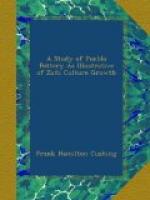[Illustration: FIG. 539.—Section of incipient vessel in basket-mold.]
[Illustration: FIG. 540.—Section of vessel supported for drying.]
I infer this because, to-day, a Zuni woman is quite at a loss how to hollow the bottom of a water-jar if she does not possess a form or mold made from the base of some previously broken jar of the same type. She therefore, carefully preserves these precious bottoms of her broken ollas, even cementing together fractured ones, when not too badly shivered, with a mixture of pitch or mineral asphaltum and sand. I have seen as many as a dozen or more of these molds (see Fig. 541) in a single store room.
[Illustration: FIG. 541.—Base-mold (bottom of water-jar).]
As the practice of molding all new vessels of this class in the bottoms of older ones was general—I might say invariable—any peculiarities of form in the originals must have been communicated to those ensuing; from the latter to others, and so on, though in less and less degree, to the present time. This theory is but tentative, yet it would also explain, on the score of association, why the Pueblo women slightly prefer the jars showing the indentation in question to more regular ones. With the change from elevated cliff or mesa habitations to more accessible ones, the Pueblo Indians were enabled to enlarge the apertures of their water-jars, since not only did the concave bases of the latter make the balancing of them more secure, but the trails over which they had to be carried from watering place to habitation were less rugged. A natural result of this enlargement of the openings, which admitted access with the scraper to the interior peripheries of the thin-walled jars, was the rounding upward of their shoulders, making them taller in proportion to their diameters. This modification of form in the water-jar, taken in connection with the fact that thus changed, it displaced the daily use of the canteen, explains the totally dissimilar names which were applied to the two types. The older, or spheroidal olla, was known as the k’iap ton ne, from k’ia pu, to place or carry water in, and tom me; while the newer olla is called k’ia wih na k’ia te ele, from k’ia wih na ki’a na ki’a, for bringing of water: te, earthen-ware, and e’ le or e’l lai e, to stand or standing. The latter term, te e le, is generic, being applied to nearly all terra cotta vessels which are taller than they are broad. Te, earthen ware, is derived from t’eh’, the root also of te ne a, to resound, to sound hollow; while e le, from e’l le or el’ lai e, to stand, is obviously applied in significance of comparative height as well as of function.
Thus I have thrown together a few conjectures and suggestions relative to the origin of the Southwestern pottery and the evolution of its principal forms.




